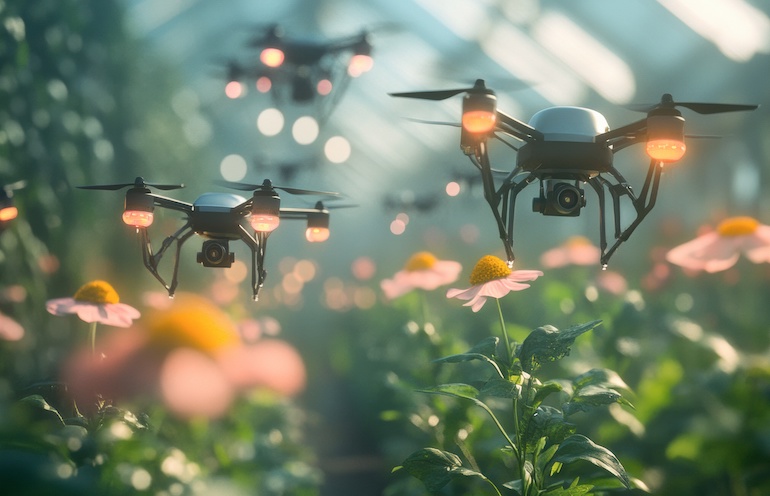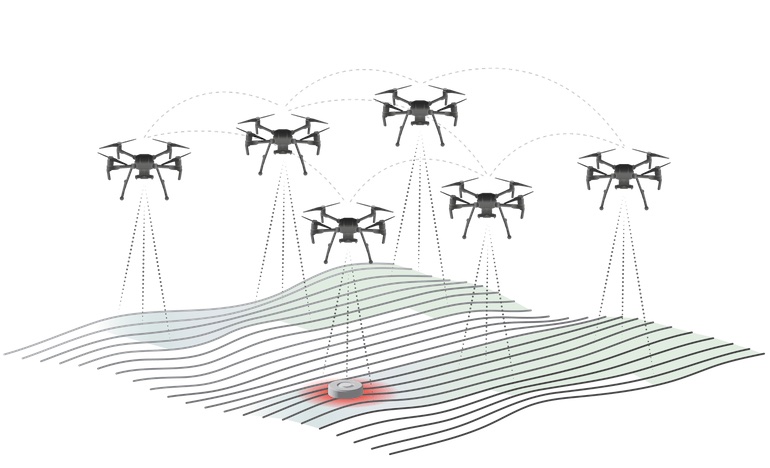
Drone swarms promise flexibility and real-time insights in agriculture. Source: Adobe Stock, AI-generated
In the right cases, drone swarms can cut operating costs by up to 30% over time. Most of that comes from lower labor costs, which can make up as much as 70% of total drone usage expenses.
These figures are more than just data points to me — they’re what first drew me to the field. Drone swarm technology first gained my attention in 2015, marking the beginning of its transition from concept to application.
Since then, I’ve closely followed its evolution and now see a strong case for integrating drone swarms into my current project. My perspective on drone swarms comes from a strong technical foundation (bachelor’s and master’s degrees in applied physics and mathematics). I also have more than a decade of hands-on experience with drones and a solid business track record as former chief operating officer of Aeroxo, plus more than 10 years in venture as a technology expert.
Let’s look at what drone swarms really are and how they function, since the term is often misused for simpler tech. Many observers call any group of drones a swarm. For example, they may describe sky shows and label certain security use cases as swarms. But these differ greatly from real swarms because they rely on centralized control, follow preset tasks without self-coordination or peer-to-peer communication, and operate under human supervision.
I’ll also examine key use cases that could emerge over the next five years.
What is actually a drone swarm?
A drone swarm is a group of uncrewed aerial vehicles (UAVs) equipped with a system that allows them to act like natural swarms of ants, bees, or birds. The comparison matters because it’s the natural swarm traits that make this technology so powerful:
- Decentralized decision-making: Each drone makes decisions on its own based on programmed rules, local conditions, and other drones’ behavior. There is no hierarchy.
- Drones sync their behavior with one another and adjust in real time based on the position, movement, or status of nearby drones.
- Each drone has the same capabilities.
- Each drone tackles a task in the same way as the rest of the group. There’s no conflicting behavior, and they don’t need to communicate to coordinate. They simply know the others made the same choice.
Thanks to the characteristics, the technology is highly scalable. The effectiveness will remain the same as you add more UAVs. Drone swarms can scan huge areas quickly with minimal human involvement, operate in complex or hazardous environments, and adapt instantly to changes.

How drone swarms work in practice
Here’s how autonomous drone swarms operate in real-world agricultural settings. The system relies on smart coordination, real-time data, and task-based decision-making across multiple units.
- Drones come with an onboard computer for swarm coordination and carry tools specific to agricultural tasks, such as a multispectral camera, a fertilizer tank and dispenser, and GPS + RTK (real-time kinematics).
- A human sets the task. For instance, it might be to apply fertilizer only to the areas that need it, based on soil type, moisture, and nutrient levels. This saves costs and prevents damage from over- or under-fertilizing.
- One drone detects a spot with low phosphorus levels using the Normalized Difference Vegetation Index (NDVI).
- If that drone has enough phosphorus and is closest to the spot, it applies the fertilizer. If another drone with the same fertilizer is closer, it takes over.
- This process continues across the entire assigned area.
What are the best and realistic use cases for drone swarms?
These are use cases where drone swarm technology could be implemented in the next five years and deliver high impact and significant cost savings.
Agriculture
In agriculture, drone swarms can cover ground faster and more efficiently than single drones. Compared with manned systems or satellites, drone swarms offer real-time insights, field-level resolution, greater flexibility, and automation.
I explained in the section above how they can work: by enabling simultaneous monitoring, land and plant analysis, and crop spraying.
Other tasks that drone swarms can optimize include:
- Coordinated seeding
- Multi-angle imaging for 3D field reconstruction
- Early detection of disease or drought stress
The main challenge in applying this technology to agriculture is cost. In some U.S. states, for example, you can rent an agricultural airplane with a pilot for $150 an hour. That’s so cheap that drones just can’t compete, at least not yet.
We need time for technology to catch up. Drones are getting better and cheaper. Batteries are becoming more affordable. But progress is incremental, not breakthrough-based. Ten years ago, a multispectral camera for NDVI analysis cost $6,000 or more. Today, similar cameras can go for as little as $500. It’s just a matter of time.
The Wyss Institute at Harvard is developing autonomous flying robots called RoboBees, inspired by insect swarm behavior. Each unit is designed to collect environmental data and coordinate with others to monitor crops and identify problem zones in real time.
The platform is still in lab stages and limited by payload capacity and flight time, but it shows the viability of decentralized coordination in complex field environments.
Humanitarian demining
The main reason for the high costs of the humanitarian demining process is the multiple false alarms treated as real threats. A team typically clears more than 50 suspected mines before finding one landmine.
Drone swarms could push humanitarian demining toward a zero-tolerance standard, with up to 98% detection accuracy and significantly reduced research time.
Here is how drone swarms may work in humanitarian demining:
- Each drone has a radar that works in different wavebands, for example, L-band and X-band.
- L-band has a longer wavelength and can penetrate slightly below the ground. It’s used for broader subsurface detection.
- X-band has a shorter wavelength, which doesn’t penetrate soil or foliage well, but provides much higher resolution.
- The drones autonomously scan a suspected hazardous area (SHA) to identify spots likely to contain mines. During the flight, the onboard AI detects anomalies in real time. Drones choose the waveband based on the soil, the type of explosive remnants of war (ERW) used during the conflict in these areas, the season, vegetation, and precipitation.
- When one drone spots an anomaly, nearby drones automatically move to the same location to rescan it from different angles and with different radar bands.
- The collected data is sent to a large AI model for deeper analysis and precise mapping of contaminated zones.
To realize drone swarms in humanitarian demining, we need time for three technologies to develop:
- Processing power to process radar data onboard online to detect anomalies in real time. Currently, drones can only collect the data during flight, which we analyze later on the ground. We also need more advanced processing power to support drone swarm synchronization. Each drone must know its exact position, send and receive radar signals at the same time, and coordinate scans without interference, all while producing a consistent dataset. Current chips are not yet powerful enough for this complexity, but I strongly expect suitable hardware to be available by 2027.
- GPS and visual odometry need further development to improve positioning accuracy relative to the ground and nearby objects. These systems exist, but their precision still falls short for drone swarm coordination in demining operations.
- Antenna design to support multiband radar scanning, drones need lightweight, compact antennas. Unlike the first two challenges, which require ongoing research and development, this one is primarily an engineering problem that can be addressed with existing technology.
Research is already under way in this area. The Department of Mechanical and Aerospace Engineering at Sapienza University is testing drone swarms equipped with ground-penetrating radar to scan terrain in a structured way. For now, it uses only one type of waveband, it may have tested different wavelengths.

Denmark-based Dropla is among the developers of drones for demining. Source: Dropla
Logistics
Logistics is a natural fit for drone swarms because it’s a distributed problem — multiple moving parts, locations, and decisions. Drone swarms turn that into an autonomous system that’s faster, cheaper, and more resilient than centralized or single-drone models.
An autonomous drone network can decide which system delivers which package based on location, remaining battery, package weight, and destination distance.
Other than the technology cost — since traditional delivery is still much cheaper — the main barrier to realizing drone swarms in logistics is regulation. If something falls and injures a bystander, the authorities are the first to be questioned. That’s why they need tens of thousands of real-world tests to confirm safety, and why many procedures and rules must be created and refined. For example, how drones communicate with piloted aircraft and what certifications drone pilots need.
Swarm principles are already being tested in commercial settings. ZenaDrone, for instance, is developing autonomous drone fleets for indoor inventory management. The company’s drones operate in synchronized patterns to scan shelving units, track parts, and optimize storage in real time.
These systems are currently limited to controlled environments and rely on visual markers or lidar-based mapping for navigation. However, they offer a working demonstration of how drone swarms can bring distributed intelligence to supply chain operations.
Drone swarms prove their value
Across agriculture, demining, and logistics, swarm technology proves most valuable where scale, autonomy, and adaptability matter. In each case, multiple agents working together outperform single-drone systems in speed, precision, and cost-efficiency.
The key technical barrier today is onboard processing power — drones need to analyze data and coordinate in real time without external control. Now is the right time to focus on this space since swarm tech is moving from possible to practical.
 About the author
About the author
Vladimir Spinko is the founder of Aery Bizkaia, a Spain-based deep-tech startup developing AI-powered CSAR (combat search and rescue) radar systems for autonomous landmine detection. A graduate of MIPT and former COO at Aeroxo, he combines advanced physics, aerospace innovation, and humanitarian impact to redefine post-conflict safety.
